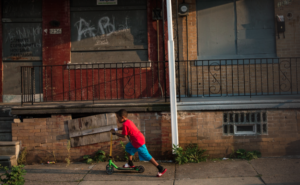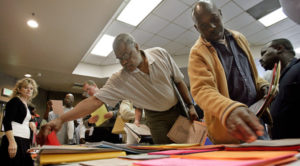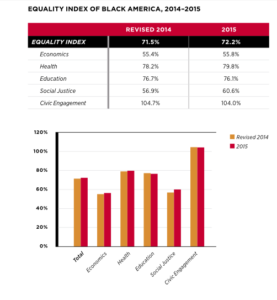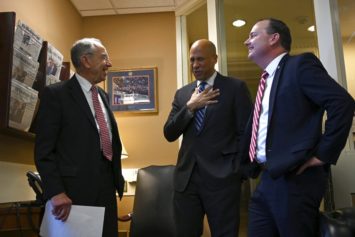
While these steps towards progress are positive signs, they do not mark a time of great overall progress for the Black community or call for a massive celebration.
Despite these statistics, Black America is still in a “crisis” on all fronts as the community continues to lag behind the white community in economic equality, educational equality, social equality, income equality, health equality, and equality under the justice system.
Following the recent deaths of unarmed Black men by police, the exposure of several major corporations caught discriminating against Black people, the 50th anniversary of Selma that resulted in solemn reflections on progress in the Black community and many other moments that garnered national attention, one can’t help but wonder how far the Black community has actually come in recent years.
According to the 2015 State of Black America report released by the National Urban League, the answer is about as surprising as the lack of indictments against white police officers who fatally shot unarmed Black citizens.
As many probably already expected, the report confirmed that while steps towards progress have been made when it comes to social justice, the Black community is still trailing extremely far behind white Americans in nearly every aspect of life.
The report used what they refer to as an equality index to determine the size of inequality gaps in areas such as economics, education and health.
Taking all things into consideration, the report suggested that Black Americans are about 72 percent equal to white people.
A 100 percent score would mean both parties were equal.
Unfortunately, even an overall score as low as 72 percent doesn’t fully capture the lack of progress for the Black community.
It’s the more specific scores that help emphasize that bleak reality.
When it comes to economic inequality, arguably one of the most important aspects to consider when discussing equality, the index plummets to 55.8 percent, a miniscule increase from last year’s index of 55.4 percent.
It’s a reminder that while unemployment rates did decrease in the Black community, the gaps in economics and even employment are still significant.
Marc Morial, president and CEO of the National Urban League, admitted that the findings weren’t a complete shock to him although he was startled by the racial disparities that still exist in the job market.
“The fact that the unemployment rate in Black America is still very high, even after we’ve been into this recovery, is a surprise,” Morial told Atlanta Blackstar.
The report also revealed that the unemployment gap and the homeownership gap between Black and white communities actually widened.
Morial added that while job creation was certainly something to be happy about, the fact that enough progress hasn’t been made to significantly reduce the gap between unemployment rates in Black communities and white communities is an unfortunate reminder that the nation not only has a long way to go, but it may not have gone nearly as far as most people once believed.
The equality index for education came in at 76.1 percent, a slight decrease from last year’s score of 76.7.
This means the quality of education that Black children are receiving is continuing to decline while educational opportunities for white students is continuing to expand.
This is particularly troubling considering the fact that quality education is a key part of solving economic issues in the Black community.
With disadvantages starting to impact the lives of Black people as early as kindergarten, Black youth are often placed in a position where their entire life is a seemingly hopeless game of “catch-up” with their white peers.
It’s a game that too often leaves them far off in the distance.
Good news was hard to come by in the report as areas that saw improvement saw very slight improvements.
The health index increased from 78.2 percent to 79.8 percent. It’s a small increase but one should also keep in mind it’s an increase that came after only one year.
Surprisingly enough, however, the core contributor to the increase in health equality is the same piece of legislation that so many are adamantly fighting against—President Obama’s Affordable Care Act.
“The increase in the health index resulted from increased health care coverage for Blacks since the Affordable Care Act went into effect and a decline in binge drinking among Blacks, while the rates for whites continued to climb,” the report explains.
According to Morial, it’s evidence that there are times when “public-policy interventions” actually help the Black community.
It’s not an idea that too many low-income communities believe in. The passing of legislation that actually helps any marginalized community, nonetheless the Black community, is like some sort of rare political solar eclipse that will only happen every few decades.
Even though the changes were slight, it’s proof that the government does have the ability to make a meaningful impact on Black citizens.
With that fact in mind, Morial is presenting the nation’s leaders with a few clear examples of what they could be doing to help spark actual progress for marginalized people.
“Now I will say that there are some opportunities out there so here’s what the Urban League wants to see,” Morial said. “We want to see a comprehensive youth employment bill that would include summer jobs and year-round jobs…Second, we’d like to see a transportation funding bill to focus on bridges and roads and infrastructure in urban communities.”
The transportation bill would come with a special provision as well, according to Morial’s plan.
The projects should specifically focus on creating jobs for low-income people of color.
It’s a strategy that he says can boost employment in Black communities while also contributing to the nation’s economy overall.
It would essentially be an attempt to take back an industry that has been historically used to discriminate against Black citizens and use it as a catalyst to spark change for those very same people.

Now that the community has more than ample evidence to prove that Black America is still in the midst of a “crisis,” hopefully activists, leaders, entrepreneurs and other people of all cultures and all backgrounds will realize that discussions of racism aren’t enough.
Awkward discussions of race over pumpkin space lattes at Starbucks aren’t digging anybody out of poverty or giving Black people the jobs they are constantly being cheated out of thanks to racially biased hiring practices.
Even the most clever of hashtags won’t help the countless numbers of Black students who are still failing to obtain proficient scores when their math and reading skills are put to the test.
The specific numbers provided by the State of Black America report make it unnecessary to keep launching conversations about whether a problem exists and how bad it really is.
We have an answer.
The problem is real. It’s evident. It’s pretty bad—like 50 years of no progress bad. It won’t go away with conversation.
It could, however, start to diminish with action.



